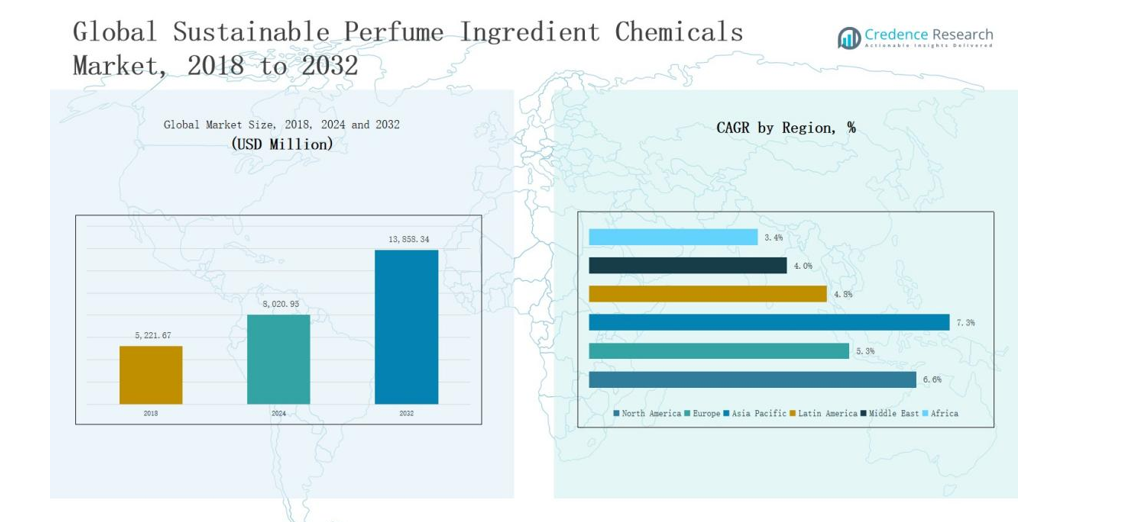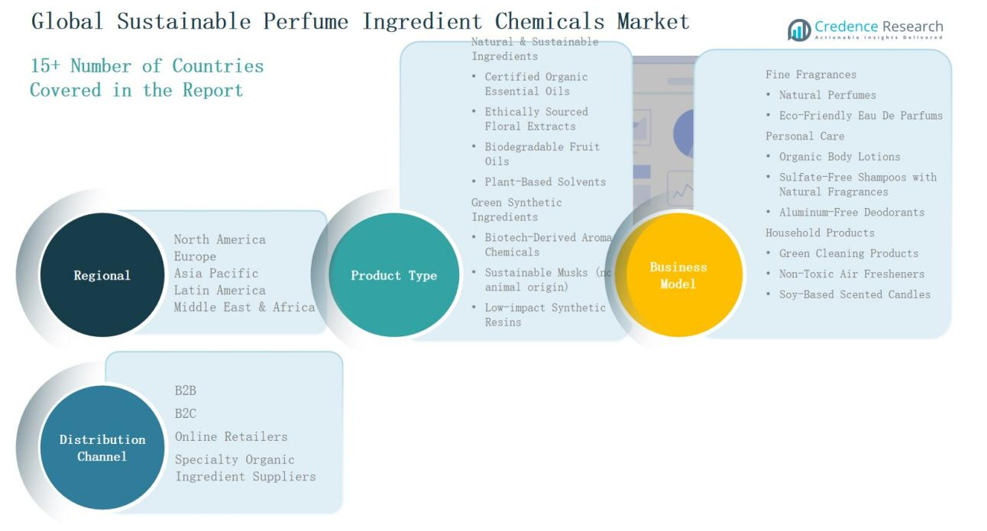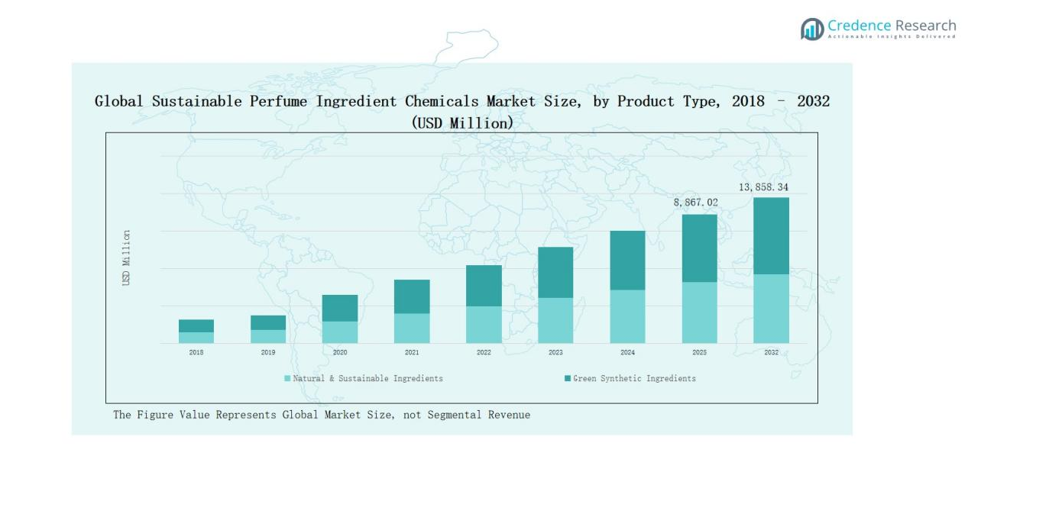CHAPTER NO. 1: GENESIS OF THE MARKET
1.1 Market Prelude – Introduction & Scope
1.2 The Big Picture – Objectives & Vision
1.3 Strategic Edge – Unique Value Proposition
1.4 Stakeholder Compass – Key Beneficiaries
CHAPTER NO. 2: EXECUTIVE LENS
2.1 Pulse of the Industry – Market Snapshot
2.2 Growth Arc – Revenue Projections (USD Million)
2.3. Premium Insights – Based on Primary Interviews
CHAPTER NO. 3: SUSTAINABLE PERFUME INGREDIENT CHEMICALS MARKET FORCES & INDUSTRY PULSE
3.1 Foundations of Change – Market Overview
3.2 Catalysts of Expansion – Key Market Drivers
3.2.1 Momentum Boosters – Growth Triggers
3.2.2 Innovation Fuel – Disruptive Technologies
3.3 Headwinds & Crosswinds – Market Restraints
3.3.1 Regulatory Tides – Compliance Challenges
3.3.2 Economic Frictions – Inflationary Pressures
3.4 Untapped Horizons – Growth Potential & Opportunities
3.5 Strategic Navigation – Industry Frameworks
3.5.1 Market Equilibrium – Porter’s Five Forces
3.5.2 Ecosystem Dynamics – Value Chain Analysis
3.5.3 Macro Forces – PESTEL Breakdown
3.6 Price Trend Analysis
3.6.1 Regional Price Trend
3.6.2 Price Trend by Product
CHAPTER NO. 4: KEY INVESTMENT EPICENTER
4.1 Regional Goldmines – High-Growth Geographies
4.2 Product Frontiers – Lucrative Product Categories
4.3 Application Sweet Spots – Emerging Demand Segments
CHAPTER NO. 5: REVENUE TRAJECTORY & WEALTH MAPPING
5.1 Momentum Metrics – Forecast & Growth Curves
5.2 Regional Revenue Footprint – Market Share Insights
5.3 Segmental Wealth Flow – Product Type & Distribution Channel Revenue
CHAPTER NO. 6: TRADE & COMMERCE ANALYSIS
6.1. Import Analysis by Region
6.1.1. Global Sustainable Perfume Ingredient Chemicals Import Revenue By Region
6.2. Export Analysis by Region
6.2.1. Global Sustainable Perfume Ingredient Chemicals Export Revenue By Region
CHAPTER NO. 7: COMPETITION ANALYSIS
7.1. Company Market Share Analysis
7.1.1. Global Sustainable Perfume Ingredient Chemicals: Company Market Share
7.2. Global Sustainable Perfume Ingredient Chemicals Company Revenue Market Share
7.3. Strategic Developments
7.3.1. Acquisitions & Mergers
7.3.2. New Product Launch
7.3.3. Regional Expansion
7.4. Competitive Dashboard
7.5. Company Assessment Metrics, 2024
CHAPTER NO. 8: SUSTAINABLE PERFUME INGREDIENT CHEMICALS MARKET – BY PRODUCT TYPE SEGMENT ANALYSIS
8.1. Sustainable Perfume Ingredient Chemicals Overview by Product Type Segment
8.1.1. Sustainable Perfume Ingredient Chemicals Revenue Share By Product Type
8.2. Natural & Sustainable Ingredients
8.2.1. Certified Organic Essential Oils
8.2.2. Ethically Sourced Floral Extracts
8.2.3. Biodegradable Fruit Oils
8.2.4. Plant-Based Solvents
8.3. Green Synthetic Ingredients
8.3.1. Biotech-Derived Aroma Chemicals
8.3.2. Sustainable Musks (non-animal origin)
8.3.3. Low-impact Synthetic Resins
CHAPTER NO. 9: SUSTAINABLE PERFUME INGREDIENT CHEMICALS MARKET – BY APPLICATION SEGMENT ANALYSIS
9.1. Sustainable Perfume Ingredient Chemicals Overview by Application Segment
9.1.1. Sustainable Perfume Ingredient Chemicals Revenue Share By Application
9.2. Fine Fragrances
9.2.1. Natural Perfumes
9.2.2. Eco-Friendly Eau De Parfums
9.3. Personal Care
9.3.1. Organic Body Lotions
9.3.2. Sulfate-Free Shampoos with Natural Fragrances
9.3.3. Aluminum-Free Deodorants
9.4. Household Products
9.4.1. Green Cleaning Products
9.4.2. Non-Toxic Air Fresheners
9.4.3. Soy-Based Scented Candles
CHAPTER NO. 10: SUSTAINABLE PERFUME INGREDIENT CHEMICALS MARKET – BY DISTRIBUTION CHANNEL SEGMENT ANALYSIS
10.1. Sustainable Perfume Ingredient Chemicals Overview by Distribution Channel Segment
10.1.1. Sustainable Perfume Ingredient Chemicals Revenue Share By Distribution Channel
10.2. B2B
10.3. B2C
10.4. Online Retailers
10.5. Specialty Organic Ingredient Suppliers
CHAPTER NO. 11: SUSTAINABLE PERFUME INGREDIENT CHEMICALS MARKET – REGIONAL ANALYSIS
11.1. Sustainable Perfume Ingredient Chemicals Overview by Region Segment
11.1.1. Global Sustainable Perfume Ingredient Chemicals Revenue Share By Region
11.1.2. Region
11.1.3. Global Sustainable Perfume Ingredient Chemicals Revenue By Region
11.1.4. Product Type
11.1.5. Global Sustainable Perfume Ingredient Chemicals Revenue By Product Type
11.1.6. Application
11.1.7. Global Sustainable Perfume Ingredient Chemicals Revenue By Application
11.1.8. Distribution Channel
11.1.9. Global Sustainable Perfume Ingredient Chemicals Revenue By Distribution Channel
CHAPTER NO. 12: NORTH AMERICA SUSTAINABLE PERFUME INGREDIENT CHEMICALS MARKET – COUNTRY ANALYSIS
12.1. North America Sustainable Perfume Ingredient Chemicals Overview by Country Segment
12.1.1. North America Sustainable Perfume Ingredient Chemicals Revenue Share By Region
12.2. North America
12.2.1. North America Sustainable Perfume Ingredient Chemicals Revenue By Country
12.2.2. Product Type
12.2.3. North America Sustainable Perfume Ingredient Chemicals Revenue By Product Type
12.2.4. Application
12.2.5. North America Sustainable Perfume Ingredient Chemicals Revenue By Application
12.2.6. Distribution Channel
12.2.7. North America Sustainable Perfume Ingredient Chemicals Revenue By Distribution Channel
2.3. U.S.
12.4. Canada
12.5. Mexico
CHAPTER NO. 13: EUROPE SUSTAINABLE PERFUME INGREDIENT CHEMICALS MARKET – COUNTRY ANALYSIS
13.1. Europe Sustainable Perfume Ingredient Chemicals Overview by Country Segment
13.1.1. Europe Sustainable Perfume Ingredient Chemicals Revenue Share By Region
13.2. Europe
13.2.1. Europe Sustainable Perfume Ingredient Chemicals Revenue By Country
13.2.2. Product Type
13.2.3. Europe Sustainable Perfume Ingredient Chemicals Revenue By Product Type
13.2.4. Application
13.2.5. Europe Sustainable Perfume Ingredient Chemicals Revenue By Application
13.2.6. Distribution Channel
13.2.7. Europe Sustainable Perfume Ingredient Chemicals Revenue By Distribution Channel
13.3. UK
13.4. France
13.5. Germany
13.6. Italy
13.7. Spain
13.8. Russia
13.9. Rest of Europe
CHAPTER NO. 14: ASIA PACIFIC SUSTAINABLE PERFUME INGREDIENT CHEMICALS MARKET – COUNTRY ANALYSIS
14.1. Asia Pacific Sustainable Perfume Ingredient Chemicals Overview by Country Segment
14.1.1. Asia Pacific Sustainable Perfume Ingredient Chemicals Revenue Share By Region
14.2. Asia Pacific
14.2.1. Asia Pacific Sustainable Perfume Ingredient Chemicals Revenue By Country
14.2.2. Product Type
14.2.3. Asia Pacific Sustainable Perfume Ingredient Chemicals Revenue By Product Type
14.2.4. Application
14.2.5. Asia Pacific Sustainable Perfume Ingredient Chemicals Revenue By Application
14.2.5. Distribution Channel
14.2.7. Asia Pacific Sustainable Perfume Ingredient Chemicals Revenue By Distribution Channel
14.3. China
14.4. Japan
14.5. South Korea
14.6. India
14.7. Australia
14.8. Southeast Asia
14.9. Rest of Asia Pacific
CHAPTER NO. 15: LATIN AMERICA SUSTAINABLE PERFUME INGREDIENT CHEMICALS MARKET – COUNTRY ANALYSIS
15.1. Latin America Sustainable Perfume Ingredient Chemicals Overview by Country Segment
15.1.1. Latin America Sustainable Perfume Ingredient Chemicals Revenue Share By Region
15.2. Latin America
15.2.1. Latin America Sustainable Perfume Ingredient Chemicals Revenue By Country
15.2.2. Product Type
15.2.3. Latin America Sustainable Perfume Ingredient Chemicals Revenue By Product Type
15.2.4. Application
15.2.5. Latin America Sustainable Perfume Ingredient Chemicals Revenue By Application
15.2.6. Distribution Channel
15.2.7. Latin America Sustainable Perfume Ingredient Chemicals Revenue By Distribution Channel
15.3. Brazil
15.4. Argentina
15.5. Rest of Latin America
CHAPTER NO. 16: MIDDLE EAST SUSTAINABLE PERFUME INGREDIENT CHEMICALS MARKET – COUNTRY ANALYSIS
16.1. Middle East Sustainable Perfume Ingredient Chemicals Overview by Country Segment
16.1.1. Middle East Sustainable Perfume Ingredient Chemicals Revenue Share By Region
16.2. Middle East
16.2.1. Middle East Sustainable Perfume Ingredient Chemicals Revenue By Country
16.2.2. Product Type
16.2.3. Middle East Sustainable Perfume Ingredient Chemicals Revenue By Product Type
16.2.4. Application
16.2.5. Middle East Sustainable Perfume Ingredient Chemicals Revenue By Application
16.2.6. Distribution Channel
16.2.7. Middle East Sustainable Perfume Ingredient Chemicals Revenue By Distribution Channel
16.3. GCC Countries
16.4. Israel
16.5. Turkey
16.6. Rest of Middle East
CHAPTER NO. 17: AFRICA SUSTAINABLE PERFUME INGREDIENT CHEMICALS MARKET – COUNTRY ANALYSIS
17.1. Africa Sustainable Perfume Ingredient Chemicals Overview by Country Segment
17.1.1. Africa Sustainable Perfume Ingredient Chemicals Revenue Share By Region
17.2. Africa
17.2.1. Africa Sustainable Perfume Ingredient Chemicals Revenue By Country
17.2.2. Product Type
17.2.3. Africa Sustainable Perfume Ingredient Chemicals Revenue By Product Type
17.2.4. Application
17.2.5. Africa Sustainable Perfume Ingredient Chemicals Revenue By Application
17.2.6. Distribution Channel
17.2.7. Africa Sustainable Perfume Ingredient Chemicals Revenue By Distribution Channel
17.3. South Africa
17.4. Egypt
17.5. Rest of Africa
CHAPTER NO. 18: COMPANY PROFILES
18.1. Givaudan
18.1.1. Company Overview
18.1.2. Product Portfolio
18.1.3. Financial Overview
18.1.4. Recent Developments
18.1.5. Growth Strategy
18.1.6. SWOT Analysis
18.2. Firmenich (DSM‑Firmenich)
18.3. Symrise AG
18.4. International Flavors & Fragrances (IFF)
18.5. BASF SE
18.6. Takasago International Corporation
18.7. Mane SA






